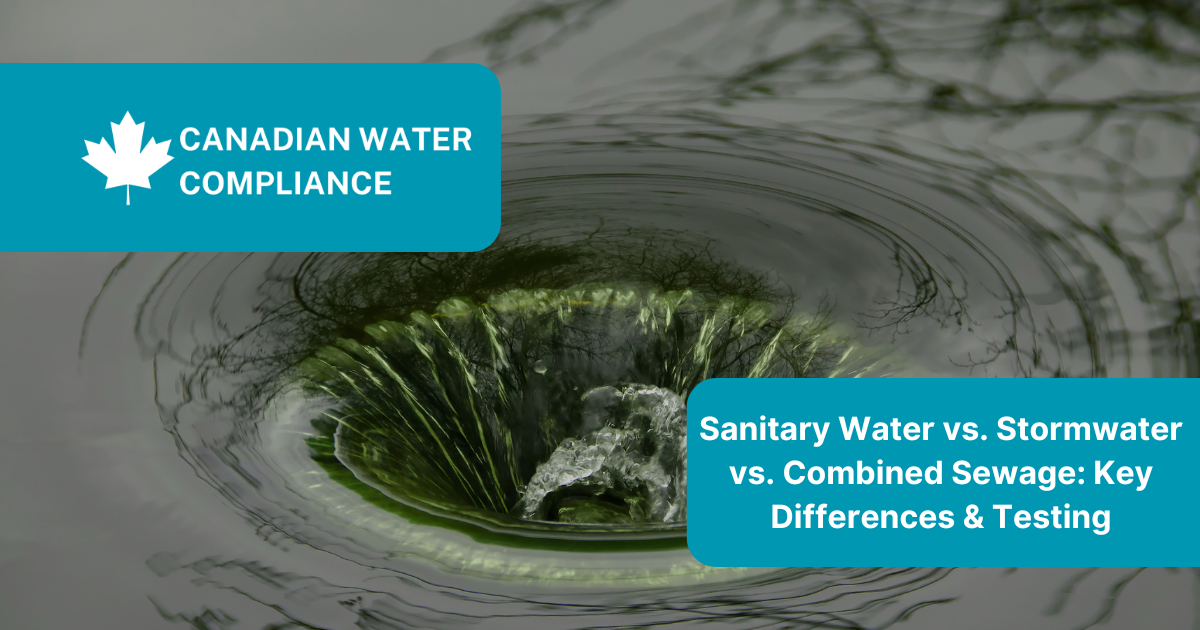
Written By: Canadian Water Compliance | On
Water quality testing varies widely depending on the type of water being analyzed. In municipalities across Ontario and Canada, different parameters are monitored to ensure compliance with environmental and public health regulations. This article explores the key differences between sanitary water, stormwater, and combined sewage, including their distinct sources, risks, and testing requirements.
Sanitary water, often referred to as wastewater, is water that has been used in homes, businesses, and industries. It flows through the sanitary sewer system to wastewater treatment plants before being discharged into the environment.
🔹 Sources: Residential sinks, toilets, showers, washing machines, commercial and industrial processes.
🔹 Common Contaminants: Bacteria, viruses, nutrients (nitrogen, phosphorus), heavy metals, pharmaceuticals, personal care products, and organic matter.
🔹 Testing Parameters:
Biological Oxygen Demand (BOD) – Measures the amount of organic material in water that bacteria can break down.
Total Suspended Solids (TSS) – Indicates the level of particulate matter.
E. coli & Coliform Bacteria – Monitors for fecal contamination.
Nutrient Levels (Nitrates, Phosphates) – High levels can cause eutrophication in receiving waters.
pH & Alkalinity – Determines acidity and buffering capacity.
Metals & Toxic Chemicals – Ensures compliance with industrial discharge limits.
Stormwater is precipitation runoff from urban and rural areas that flows into storm drains, streams, and rivers without treatment.
🔹 Sources: Rain, snowmelt, runoff from roads, parking lots, and construction sites.
🔹 Common Contaminants: Sediment, oil, grease, heavy metals, road salts, pesticides, bacteria, nutrients.
🔹 Testing Parameters:
Turbidity & TSS – Measures sediment levels.
Oil & Grease – Identifies pollution from vehicle and industrial sources.
E. coli & Fecal Coliform – Detects bacterial contamination.
Metals (Lead, Copper, Zinc, Cadmium) – Monitors for toxic runoff.
pH & Conductivity – Assesses water chemistry.
Nutrient Levels (Nitrogen, Phosphorus) – High levels contribute to algal blooms.
Combined sewage is a mix of sanitary water and stormwater in older municipal systems where both flow into the same pipes. During heavy rainfall, these systems can become overwhelmed, leading to Combined Sewer Overflows (CSOs), which discharge untreated sewage directly into water bodies.
🔹 Sources: Sanitary wastewater + stormwater runoff.
🔹 Common Contaminants: All contaminants found in both sanitary and stormwater.
🔹 Testing Parameters:
All sanitary & stormwater parameters.
Chemical Oxygen Demand (COD) – Measures organic and inorganic pollutants.
Ammonia & Nitrogen Levels – Can be toxic to aquatic life.
Pharmaceuticals & Personal Care Products (PPCPs) – Monitors emerging contaminants.
Microplastics – Increasingly tested for due to environmental concerns.
Municipalities set specific testing guidelines based on environmental regulations, local water conditions, and infrastructure. Some key differences include:
✔️ Ontario’s Municipal Industrial Strategy for Abatement (MISA): Requires industries to test for specific pollutants before discharging into municipal sewers.
✔️ Toronto’s Wet Weather Flow Master Plan: Focuses on reducing stormwater contamination through monitoring and green infrastructure.
✔️ Ottawa’s Sewer Use By-law: Sets strict effluent limits for metals, nutrients, and pH in sanitary and combined sewers.
✔️ Hamilton’s CSO Management Strategy: Includes real-time monitoring of overflow events and bacteria levels.
✔️ Peel Region’s Stormwater Credit Program: Encourages businesses to manage runoff by testing and treating stormwater onsite.
📌 Prevents environmental contamination – Protects water bodies from pollutants.
📌 Ensures regulatory compliance – Avoids fines and legal action.
📌 Improves public health – Reduces exposure to harmful bacteria and chemicals.
📌 Optimizes wastewater treatment – Identifies inefficiencies in municipal systems.
Canadian Water Compliance offers comprehensive testing for sanitary water, stormwater, and combined sewage to help businesses, municipalities, and industries meet compliance standards.
📞 Call us at (416) 488-0094
📧 Email us at [email protected]
Ensure your water meets safety standards—get tested today!